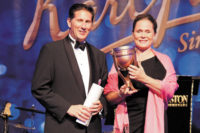Majlen Fazer loves horses. Learning to ride them at an early age, she eventually progressed to the point of entering show jumping competitions. Not only did she actively participate as a young woman, Fazer started winning events as well. The glamour and thrill of cleanly clearing a ramped oxer atop a spirited mare proved more than intoxicating to the 22 year-old.
But when her father, Peter Fazer, president of the Finnish confectionery powerhouse Fazer, asked her to consider working in the family business, it was difficult to say no. Nonetheless, Majlen thought she’d initially try her hand at confections for a short period, say a summer, and then pursue her dreams of going abroad and jumping professionally, afterwards. Moreover, having finished her degree in accounting, there was always the financial sector to fall back on.
But a funny thing happened on the way to the candy factory; the young woman found herself loving the work. Starting out as a confectioner’s assistant, Majlen found herself making cakes and buns, eventually graduating to the kitchen of the company’s café in downtown Helsinki. Her passion for the craft led her to study confectionery arts in Switzerland, working closely with famed sugar artist and pastry chef, Ewald Notter.
Returning back to Fazer after completing her education, Majlen began her life’s work, developing new products while ensuring existing brands met the highest quality standards. That passion and perseverance led her to being recognized with the European Candy Kettle Club (ECKC) Award last year.
As Majlen explains, “I’m a very down-to-earth person. I didn’t want to make a big show of this award.” But, as she adds, when Mark Sheffield [ECKC president] came to visit her last August and explained the history of the award, it was clear that Majlen was in special company, and something that required a celebration.
“I was very honored to have received this recognition,” she says. “Moreover, I know many of the people who have received it in the past.”
Indeed, her father, Peter Fazer, received the recognition in 1982. Moreover, Majlen is only the third woman in the club’s 40-year history to have been chosen; Nina Stepanova of Krupskaja being the first in 1995 and Bente Brevik of Nidar the second in 2005.
As the senior family member working in the company — Majlen is a 25-year veteran — she has become the “face of Fazer.” More importantly, Majlen, in her role as senior specialist, product quality, cocoa and chocolate, is the “godmother” of all things related to chocolate quality.
As she says, tasting cocoa liquor, which can be challenging even to professionals, is a joy for her. Naturally, it helps that she’s been involved with chocolate for a quarter century. As she explained to Tarja Valde-Brown of Eurofacts Oy in an interview several years ago, morning is the best time for her to taste chocolate, which Majlen does daily.
It’s a process of analyzing color, texture, aroma and finally taste, she says. Having savored more than her share of chocolates from around the world, Majlen unabashedly asserts KARL FAZER Milk Chocolate is still the best. She cites the use of fresh milk, a rarity these days, and the quality of the cocoa liquor, combined with a strict adherence to recipe guidelines and processing parameters.
Today, Fazer uses basically the same recipe for KARL FAZER Milk Chocolate, which dates back to 1922 and is still known by its blue wrapper. Maintaining the taste profile of Finland’s best-loved chocolate, a chocolate that nearly the entire population of that country grew up with, is a daunting task and responsibility.
During her 25 years at the company, Majlen has seen Fazer go through a number of changes, beginning with the heady days when her father Peter spearheaded the globalization of the company to its merger with Cloetta in 2000, continuing with the subsequent split and return to private ownership in 2008 under the Fazer Group, and now the most recent reorganization involving incorporating confectionery, bakery, biscuits, cafés and shops units under the Fazer Brands moniker.
Through it all, however, Majlen has remained steadfast in emphasizing the importance of quality within the company.
“Quality is critical, not only in our processes, standards and products, but also in the way we communicate, talk and act in the company,” she says. That emphasis takes on even greater importance as the company pursues a growth strategy based on leveraging its brands while simultaneously expanding into growth markets and segments with higher value products.
Given its positioning — Fazer Confectionery has nearly a 40 percent share (No. 1) of the confectionery market in Finland and 11 percent share in Nordic countries (No. 3) — the division has a strong base to take advantage of its heritage, brands and expertise.
In 2012 the confectionery division posted €344 million in sales, accounting for 20.5 percent of €1.676 billion in revenue within the Fazer Brands segment; the bakery and food services divisions comprising 45 percent (€752 million) and 35 percent (€580 million), respectively. The €344 million total reflected a €41 million increase from 2011, a 13.5 percent gain.
With three confectionery plants in Finland — a chocolate factory in Vantaa, a sugar confectionery operation in Lappeenranta and a chewing gum facility in Karkkila — the company can offer a full line of sweet treats to customers in Scandinavia and beyond.
The reorganization initiated in 2013 provides the company with an improved “readiness” to take advantage of its strengths, thereby channeling development and growth strategy from one source, says Mika Sarimo, senior v.p., confectionery business.
“We can create a road map that helps us fulfill customers’ needs through new products and subsequent investments through a single supply chain,” he explains. Within this structure, there’s also increased flexibility for individual markets (read: countries), which allows for very specific approaches to those markets, be it Sweden, Russia or the Baltic countries.
“This allows us to look at trends and see what’s happening in those markets,” adds Mika.
For example, the company purchased Kraft Foods’ biscuit production in August 2012, acquiring the Jyväshyvä, Carneval, Suklaalehti, Muro andHangon brands from the multinational. The move brought Fazer back to familiar territory; it produced biscuits from 1929 to 1995.
Familiarity doesn’t mean complacency, though. The company took advantage of its roots and strong confectionery brands by launching two new products under the Suffeli and Julia brands. Fazer’s Suffeli milk chocolate wafers with a toffee filling have been a Finnish favorite since 1966. Consequently, it made sense to capitalize on the brand’s popularity as well as the trend toward snacking by launching Suffeli Vanilla Bites and Suffeli Tryffeli Bites.
In the same vein, Finn have come to love the combination of dark chocolate and fresh apple and fruit marmalade in Julia confections, an affection that goes back to 1966. Here, too, the harmony of fruits and chocolate were combined to produce two sponge cake biscuit varieties in Original and Orange flavors under the Julia brand. Most recently, the company launched Marianne cookies, using the peppermint candy flavor as its filling for a chocolate sandwich cookie.
Biscuits and confectionery complement each other very well, points out Managing Director of Fazer Brands Finland Tom Lindblad. The reaction by retailers was very positive, particularly since the category was in need of some stimulation, he adds. As a result, Lindblad believes the company can garner a 25 percent share of the biscuit category, particularly by leveraging its storehouse of confectionery brands.
And chocolate will play a critical role. Early last year, Fazer conducted a survey amongst 1,700 Finns. Not surprisingly 71 percent of the respondents selected taste as their primary criteria when choosing biscuits. In terms of flavor, Finns’ favorites are biscuits covered with chocolate and filled biscuits.
Obviously, Majlen is involved in the product development of the new biscuit launches. As Sarimo emphasizes, she’s one of the “gate keepers” in determining whether a concept moves forward. She’s also one of the main drivers in the company’s commitment to have all cocoa ingredients certified by 2017.
“We’re looking at all the certification organizations,” Majlen says. “Currently, 40 percent of all ingredients are certified, either through UTZ or Source Trust. We’re also members of the World Cocoa Foundation and support their three principles of profit, people and planet. At the same time, we’ve added one of our principles, traceability.”
Currently, Fazer purchases 7,000 tons of cocoa liquor, cocoa butter and cocoa powder from European suppliers. Seventy-five percent of the cocoa is sourced from West Africa, including the Ivory Coast, Ghana and Nigeria, with the remaining 25 percent coming from Ecuador.
In conjunction with its commitment to traceability and sustainability, the confectionery business unit also continues to invest in technology and innovation. Last year, it invested between €17 – 18 million euros in capital investments related to processing improvements.
There will be a new licorice line installed in the company’s Lappeenranta facility this year and plans call for a new chocolate mogul line with a two-shot depositor for producing liquor-filled chocolates, marshmallow chocolates and other seasonal chocolates, Sarimo says.
It also announced the launch of the Fazer Magic line, an assortment of pralines in blueberry, raspberry and truffle flavors enrobed in dark chocolate that’s targeted toward the international travel market, specifically airport gift shops, ferries and select department stores and cafes.
The stylized packaging, which features cubes and standup boxes, includes stirring sayings to reflect a unique taste experience. The launch is also part of Fazer’s growth strategy, namely, growing sales outside of Finland. Currently 50 percent of all revenues come from abroad.
“We have a strong focus on the near-market area, including Russia and the Nordic and Baltic countries,” Sarimo says. “We also see excellent growth opportunities in the shops of international airports and ferries operating between Finland and Sweden as well as in the Middle East. In addition, Fazer is carrying out a pilot project in Hong Kong to establish Finnish chocolate in China.”
To ensure that supply meets projected demand, the company had asked Kalle (Karl) Fazer if he was interested in running the 9,500-sq.-meter chocolate. Kalle, Majlen’s younger brother, had previously directed bakery operations at the Vantaa location. So Kalle applied and took over chocolate operations.
Majlen thoroughly approves.
“He’s really good with people,” she says. “He enjoys talking to them, communicating directly with them. And he loves machines. In many ways, he’s like my grandfather, always interested in how machines run.”
And that’s a key trait, because there are now more machines to keep running, which include six chocolate moulding lines, two enrobing lines, one specialty line as well as 13 packaging lines plus six custom hand-packed packaging lines.
The company receives cocoa liquor deliveries almost daily and pumps the chocolate to any one of five Buhler five-roll refiners. Thirteen conches, ranging from three- to six- and nine-ton capacities, handle the critical chocolate development, with conching times ranging from six to 18 hours.
One interesting aspect of the Vantaa facility involves the delivery of 120,000 liters of fresh milk daily. A “milk kitchen” handles the processing of milk into condensed milk. The condensed milk is then mixed with cocoa liquor and pumped to one of five cookers. The on-site milk processing enables Fazer to produce a distinct milk chocolate taste, one that delivers a “rounder” note without having to use extra sugar.
Volume praline production revolves around one of six moulding lines. When needed, finished pralines head toward one of two Schubert pick ‘n place robotic packaging units, which can handle up to eight varieties for a broad range of boxed assortment sizes.
The premiumization movement has prompted the company to expand its hand-crafted praline department at Vantaa.
Majlen, who’s responsible for many of the premium pralines produced on the company’s specialty line, notes that occasionally there are items that don’t catch on in the marketplace, no matter how special she thinks they are.
“One of my favorite pralines, which I developed, was a chocolate, salted pistachio item,” she says. “I think it was just a bit ahead of its time. Perhaps we’ll resurrect it.”
Oh yes, Majlen still loves horses. She owns several. And while she doesn’t compete, her horses do. Nonetheless, chocolate remains her first love.
Fazer Brands (Confectionery Business) |
|

Headquarters: Vantaa, Finland Sales: €1.676 billion; (Confectionery only - €344 million) Products (confectionery only): Chocolate tablets, chocolate bars, chocolate confections and snacks, sweets and small treats, pastilles, chewing gums, seasonal products and gifts, bulk items. Brands (Primary): Karl Fazer, Dumle, Geisha, Tutti Frutti Management (Confectionery Business): Mika Sarimo, senior vice president – confectionery business |
|



















